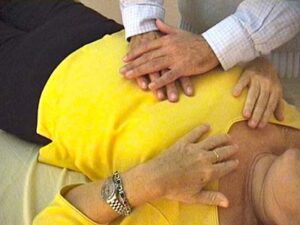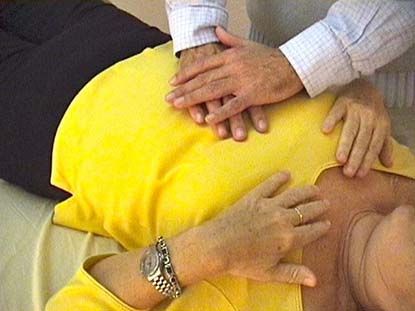
Integration of body, mind, and emotions in craniosacral therapy
summary of chapter 5
❉
Craniosacral Therapy is a profound method of body and emotional work that accesses, through the therapist’s hands, the craniosacral system, which is closely related to the nervous, musculoskeletal, vascular, endocrine, and respiratory systems.
We are all familiar with respiratory and cardiac rhythms, but not with the cranial rhythm.
By placing their hands on different parts of the body, the craniosacral therapist has learned to feel and interpret this rhythm, which is more subtle and at the core of the body. This rhythm, also called the primary respiratory mechanism (PRM), consists of wave-like pulsations (6 to 14 cycles per minute) caused by the rhythmic production and reabsorption of cerebrospinal fluid (CSF).
This clear, colorless fluid is produced in the ventricles of the brain by filtration and secretion from the capillary networks (called choroid plexuses) and circulates through the dural membrane, which internally surrounds the bones of the head, descending through the spinal cord to the sacrum and returning through the spinal cord to the brain, where it is gradually reabsorbed by the venous system. This is why the bones of the head and sacrum move slightly and acquire a certain flexibility, allowing for an expansion-contraction rhythm that affects all organs and tissues. The craniosacral therapist has learned to read and interpret the rhythm in different parts of the body, receiving information about possible imbalances and symptoms within the system.
The PRM is a form of deep, internal breathing that occurs before pulmonary breathing and is essential for the entire body (it can be palpated up to 15 minutes postmortem).
In order to understand the different approaches to craniosacral therapy, all of which are very valid in my opinion, we need to distinguish between biomechanical and biodynamic approaches. In a biomechanical approach, we tend to work with the more physical manifestations of the system. We explore primarily through active examination of movement: the axis of rotation, restrictions and imbalances in movement, and then correct them. In the biodynamic approach, the inherent self-regulating forces are used for correction. The exploration is passive, with the therapist acting more as a fulcrum of the intrinsic forces of the system.
Somatic therapies, such as craniosacral therapy, which emphasize deep touch, are generally quite effective in uncovering traumatic material, and we can use safe and effective tools and methods for its release.
❉
Stress, excitement, repression… will be reflected in characteristic muscular patterns and postures. Even past physical and emotional traumas are reflected in our tissues, what we call “energy knots” (a concept developed by American craniosacral therapy).

Energy cysts are areas of bodily dysfunction that manifest as obstructions to the efficient conduction of energy and electricity through the body’s tissues (primarily fascia). Normal bodily function has been inhibited in that area, and the body must adapt to this disorganized activity. These can be residual effects resulting from physical trauma, pathogen invasion, physiological dysfunction, and even mental and emotional problems. Taking physical trauma, such as an accident, as an example, the body has two ways of responding to the physical force of the impact:
- It immediately begins to dissipate this force and the natural healing process continues.
- or the physical force imposed on the body is retained rather than dissipated.
At a physical level, the force of impact represents excess energy, which represents force vectors entering the body. It has an entrance and an exit. (It penetrates the tissues to a depth determined by the amount of force from the collision and the density of the tissues.) If the impact energy cannot be dissipated, it becomes encapsulated or isolated, which is what we call an energy knot. The body will adapt to the presence of the knot, compromising normal functioning: the mobility of the fascia around the knot is hindered, and the normal electrical conductivity of the involved tissues is reduced. All of this weakens the body’s energy in the area of the knot, creating tension and dysfunction. This is an area of potential weakness.
There are three important factors in determining whether the body is able to dissipate traumatic energy:
- The amount of energy: The impact will create a series of force vector inputs, and will transmit an energy to the body that depends on the force and speed of the impact, counteracted by the density of the tissue. If the impact is too great, it can compromise the body’s ability to dissipate the energy of the blow. (We could also talk about emotional trauma, as we’ll see later, something the person couldn’t handle.)
- Previous injuries to the same body area: This becomes a more vulnerable area and can compromise the body’s ability to dissipate energy.
- Certain negative emotional states, such as anger or fear, paralyze the body’s ability to dissipate energy. If these negative states are dominant at the time of the accident or injury, the body will likely retain the force of the damage by developing an energetic knot. Once the negative emotions have been uncovered and relived with the therapist’s support, it will be easier to release the energetic knot.
One of the most effective techniques in craniosacral therapy for releasing energy knots of traumatic origin is the Unwinding technique. The technique is based on following the inherent movement that involuntarily occurs when holding the area to be treated away from the force of gravity.
Release is achieved when the body assumes the same position it was in when the original blow occurred, so that there is a straight path for the trapped energy to exit.
To achieve this, it is important that the therapist keep their hands neutral while performing the technique, and that the client does not consciously induce any movement. The technique consists of finding and maintaining the correct body position, the therapeutic position, until the release is achieved. The therapist must be very attentive to different signs that inform us that we have reached the correct release position: the craniosacral rhythm coming to a standstill with tension (different from the point of stillness), the release of heat, a therapeutic pulse (neuromuscular pulse of release), significant images and memories of release (remember that emotions are one of the important factors in the creation of knots), and maintain the position there.

